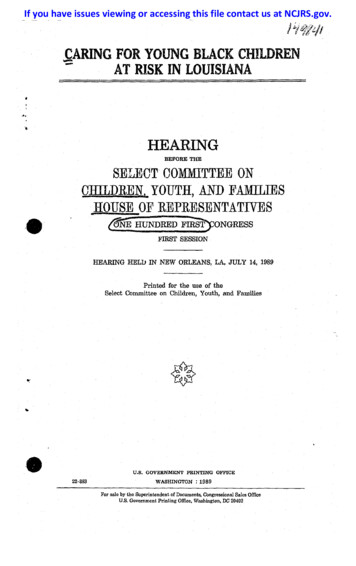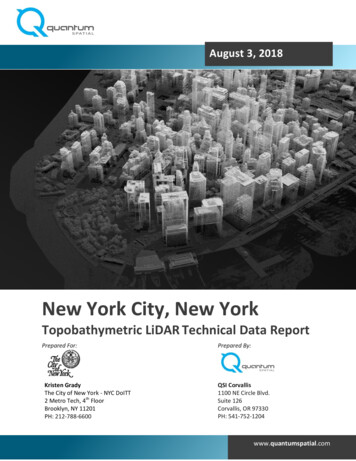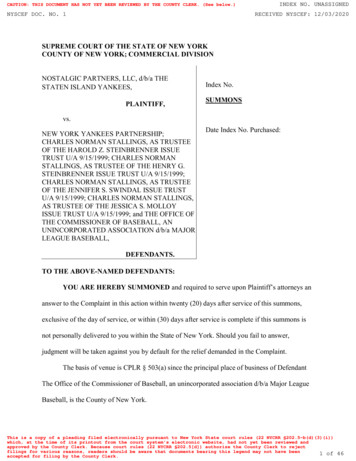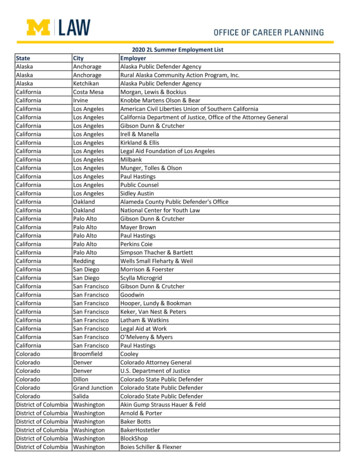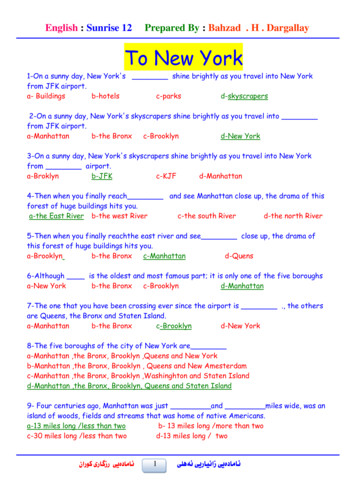
Transcription
Landmarks Preservation CommissionJune 29, 2004, Designation List 355LP- 2156(Former) NEW YORK and NEW JERSEY TELEPHONE AND TELEGRAPHBUILDING, 81 Willoughby Street (aka 119-127 Lawrence Street), Brooklyn.Built 1897-98; Rudolphe L. Daus, architect.Landmark Site: Borough of Brooklyn Tax Map Block 148, Lot 46.On May 18, 2004, the Landmarks Preservation Commission held a public hearing on theproposed designation as a Landmark of the (former) New York and New Jersey Telephone andTelegraph Company Building and the proposed designation of the related Landmark Site (ItemNo. 3). The hearing had been duly advertised in accordance with the provisions of law. Therewere three speakers in favor of designation, including representatives of the Municipal ArtSociety, the Brooklyn Heights Association and the Historic Districts Council. The Commissionalso received a letter from Councilman David Yassky in favor of designation. There were nospeakers in opposition to designation.SummaryFounded in 1883, the New York and NewJersey Telephone and Telegraph Companyserved the ever-increasing populations of LongIsland, Staten Island and northern New Jersey.The fast growth of the city and the companycreated the need for a large headquarters buildingfor this local service provider of the Bell system.This elaborate and elegantly designed BeauxArts style building served as a major statementof the company's expansion in the area,providing offices and telephone switching in theheart of Brooklyn's expanding business district.The company installed and maintained telephonewires and provided telephone . service to morethan 16,000 subscribers in 1897 when thisbuilding was constructed. Designed by leadingBrooklyn architect Rudolphe L. Daus, thebuilding's distinctive ornamentation establishes astrong presence on this busy street comer. Dausdrew on his classical French training to create adramatic structure, epitomized by the roundedcomer accented by an elaborate cartouche and adeep, projecting cornice. These design featuresare balanced by oversized arches resting onengaged columns and broad rustication of thelower floors.
DESCRIPTION AND ANALYSISExpansion of the City of Brooklyn 1The Village of Brooklyn (population 4,000) was incorporated in 1816 within the Town of Brooklyn,one of the original six towns that formed Kings County. The steam-powered ferry that ran betweenManhattan and Brooklyn, begun in 1814, provided fast and reliable access for those who worked inManhattan, and gave impetus to the development of some nearby Brooklyn residential neighborhoods,which were already growing in population. The early farms and estates in what is now Brooklyn Heightsbegan to be subdivided for building lots, while local industry thrived along the waterfront.With its population increasing and businesses flourishing, the City of Brooklyn incorporated in 1834.In an effort to bring some order to the rapidly growing city, in 1839 Brooklyn adopted its first city plan,incorporating a street grid. A civic center began to grow up around the new City Hall (begun 1836,completed 1849), at the intersection of Fulton, Joralemon and Court streets, which eventually included acourt house, a Hall of Records, and the municipal building. Brooklyn's financial district, whose firmsoften did business with government agencies, established itself near the civic center, and included banks,insurance and title guarantee companies, as well as attorneys. As in other metropolitan centers, this areaalso housed cultural institutions and centers of entertainment. The city's population grew dramatically asthe first waves of foreign-born immigrants began coming to Brooklyn in the 1840s and 50s, and theTowns of Williamsburg and Bushwick were merged into the City of Brooklyn. By the start of the CivilWar, Brooklyn's population had reached almost 267,000 and it was the third largest city in the UnitedStates. Additional growth occurred after the Civil War, due to extensive immigration, the expansion ofbusiness in the entire New York area, and the completion of the Brooklyn Bridge in 1883. New culturalinstitutions such as the Brooklyn Academy of Music, the Long Island Historical Society and the BrooklynPublic Library were reflective of the growth of the city. The outlying towns of Flatbush, Flatlands, NewUtrecht, and Gravesend were expanding as well, with street grids beginning to be mapped for these areasin the 1870s (although they were not incorporated into the city of Brooklyn until 1886 and 1896). Thecity's population of 566,663 in 1880 surged to 1.1 million in 1900 (a figure which included these newlyannexed areas) and the start of the borough's first rapid transit system in the 1890s made it easier forbusinesses to expand and for people to move around. The opening of the Brooklyn Bridge reoriented thecommercial center from the waterfront toward Fulton Street, farther inland, near the civic center. Thearea around Willoughby and Lawrence Streets was in the path of this transition, as existing homes weretown down to make way for new and growing businesses.This tremendous growth of residential as well as business activity provided a fertile market forthe emerging telephone industry and the New York and New Jersey Telephone and TelegraphCompany was ready to take on the challenge.The New York and New Jersey Telephone Company2After the first successful use of the telephone in 1875, Alexander Graham Bell received the patent forhis invention in 1876, the same year it was introduced to the public at the Centennial Exhibition inPhiladelphia. His Bell Telephone Company, founded in Massachusetts in 1877, operated by leasing thetelephone equipment to its subscribers and erecting and maintaining the telephone wires. At thebeginning, the company provided direct service from one point to another point among its localsubscribers, but the limitations of this method quickly became clear. In 1878, the Bell Companydeveloped the first switchboard exchange, enabling any user to be in contact with any other user of thesame type of equipment, creating a much wider reach for telephone service. In the same year, the NewEngland Company was founded as a subsidiary of the Bell Company, to construct, maintain and leasetelephones, call bells and telephone lines in that part of the country. Several other small independentoperators started their own local exchanges using leased equipment from the Bell Company and payingmonthly fees to subscribe to their exchanges. As the system expanded, it became obvious that it would bemore useful, economical, and prevent a duplication of effort, if everyone used the same exchanges. TheBell Company encouraged this process by licensing local exchanges and renting equipment, but leavingthe ownership and management up to local operators. One of the first local exchanges to be establishedwas the Metropolitan Telephone and Telegraph Company in 1878, with a central switching office inManhattan for 271 subscribers. 3 By 1879, the National Bell Telephone Company was incorporated, withlocal exchanges as far south as Richmond, Virginia, and reaching to most cities and towns in the MidWest. Bell subsidiary companies were gradually established throughout the United States to runtelephone lines and maintain exchanges.-2 -
The New York and New Jersey Telephone Company was founded in 1883 as one of these subsidiarycompanies of the Bell Telephone system. Its areas of service were Long Island, Staten Island and thenorthern half of New Jersey. At its creation, the company counted 2,339 subscribers and was expandingrapidly. In 1895, its telephone lines reached to Patchogue, Long Island, and the company had purchasedthe right of way to Sag Harbor and Riverhead, on the island's eastern edge. 4 By 1897, the number ofsubscribers had increased to more than 16,000, with 86 exchange stations and more than 21,000 miles oftelephone wire. 5The New York and New Jersey Telephone Company was involved in all aspects of modernizingtelephone service as its technology progressed. Beginning in 1884, the company started laying some oftheir wires underground, in "subways," a process that was formalized with the passage of a subway law inNew York in 1885. 6 Early in the twentieth century, the company began installing automated telephoneexchanges in some of its offices, doing away with operators and establishing faster service. 7 In 1909 theNew York and New Jersey Telephone Company was one of six companies in the region, serving NewYork State, northern New Jersey and parts of Philadelphia, which were consolidated into the New YorkTelephone Company. Service to New Jersey was taken over by New Jersey Bell in 1927, a situationwhich continued until the divestiture of AT&T in 1984.8Rudolphe Laurence Daus ( 1854-1916)9Rudolphe Daus was born in Mexico, and educated in the United States, Berlin and Paris, where hestudied at the Atelier Andre at the Ecole des Beaux Arts. Recognized for his excellent work at the Ecole,Mr. Daus received the Achille LeClerc medal as well as several other honors. He returned to this countryin 1879 and briefly entered the offices of Richard M. Hunt and George B. Post (two previous Beaux Artsgraduates), before establishing his own practice in 1884, in the Garfield Building in downtown Brooklyn.Forced by ill health to retire at the age of 54, Daus spent his final years in Paris, where he died in 1916.Daus's worked in a range of styles and types of buildings. He designed private residences inManhattan (his 1901 house for J. Jaros on West End Avenue was cited as being the purest example ofFrench Renaissance design in New York), Brooklyn (residence for Mr. Koechl on Montgomery Place,1905), and Long Island (including his own vacation house in Arverne-by-the-Sea, built in 1900). Dausworked on numerous public buildings as well, including the fa\:ade and entrance hall of the 13th RegimentArmory in Brooklyn (1891), a remodeling and extension of the Kings County Hall of Records (1902-05,demolished), the Wyckoff Heights Hospital (1902, formerly the German Hospital), and the Lincoln Club(1896), all in Brooklyn. A confirmed Francophile, Rudolphe Daus was a member of the Society of BeauxArts Architects, and president of the Brooklyn chapter of the American Institute of Architects. He heldmany civic positions, such as Surveyor of Buildings for Brooklyn in 1899-1900, as a member of acommission appointed in 1898 to consider building codes for the City of New York, and a member of thearchitects' committee for the Brooklyn Carnegie Libraries. Four of the Brooklyn Carnegie Libraries weredesigned by Daus, including the Flatbush, Greenpoint, Walt Whitman and Saratoga branches. He wasprominent in Catholic circles and designed or remodeled several Catholic churches and related buildings,including Our Lady of Lourdes (1897), the Monastery of the Precious Blood (1895), and the St. John'sOrphan Asylum (1901), all in Brooklyn. Daus' industrial and commercial buildings included those forthe New York County National Bank, the National Lead Company and the American Can Company, andtwo buildings for the New York and New Jersey Telephone Company (in Brooklyn and Newark, NJ).Upon his death, the Brooklyn Eagle called Rudolphe Daus, "One of the pioneers among Brooklynarchitects." 10 He was able to work in a variety of styles, from open and expansive Shingle style houses bythe sea to dignified public buildings done in an appropriate Italian Renaissance revival style. He oftenused the Romanesque revival style for church related structures, as well as for his large and impressivearmory building. Another critic at the time of his death wrote, "His work was always characterized by itsdignity and strength, and none ever strove in a nobler way and held higher the standard of hisprofession." 11The New York and New Jersey Telephone Company BuildingThe New York and New Jersey Telephone Company had its first offices on Fulton Street indowntown Brooklyn, later moving to Smith Street, before opening this large headquarters building onWilloughby Street in 1897.12 In addition to office space, the building provided a large switchingexchange for the many Brooklyn customers of the company, and was fitted with the latest fire proofingtechniques and methods for cleaning the interior air. Since it was important for telephone service to workin a dust-free area, special care was taken to "bring the air from a shaft twenty-five feet above the roof, tothe basement where it is screened through many layers of bolton cloth." A series of ducts and fans would-3 -
distribute the air through the building and then expel it above the roof. Extensive attention was given tofireproofing all telephone buildings during this period. The high cost of replacing the equipment lost tofire, as well as the loss of business to companies that had come to be reliant on telephone services madethis a necessity.Rudolphe Daus' elegant design for this large building at a comer location in downtown Brooklyn wasintended to express the importance of this new type of enterprise for individuals and businesses, as well asto the city as a whole. The building is given prominence at this busy intersection by the deeply projectingcornice and the ornate embellishments to the occulus window near the top. Elaborate terra-cottaornamentation can be found across both main facades, strategically placed to emphasize certain elementsof the composition, as well as to identify the building's occupants. The contrast between the plainsections of stone or brick and the ornament makes the later stand out more strongly. This is especiallytrue of the moldings and keystones of the large rounded arches and the elaborate occulus at the seventhstory. The rustication of the lower floors and the elaborately ornamented upper stories is typical ofFrench, Beaux-Arts style design, which the architect learned so well during the years of his study in Paris.The telephone-related motifs which frame the main entranceway on Willoughby Street add a whimsicaltouch.Subsequent HistoryAfter the New York Telephone Company became the primary sup/:?lier of telephone service in theNew York area, this building was formally conveyed to them in 1929. It has since been owned by aseries of developers and is now used by a school and for medical offices.DescriptionThe New York and New Jersey Telephone Company Building occupies an almost square site at thecomer of Willoughby and Lawrence Streets in downtown Brooklyn. Eight stories tall, it is faced withlight tan brick, limestone and terra cotta and terminates in a broadly projecting copper cornice. The twostreet facades are almost identical, each having three bays, with an additional bay located at the roundedcomer where the two sides join together. Most of the bays (except where there are building entrances)hold three, paired windows. The main entrance to the building is in the easternmost bay of theWilloughby Street fa ;ade, and the Lawrence Street fa ;ade has an altered service entrance on the groundfloor of the central bay. All the windows have been changed to 111 double-hung aluminum sash. Stonecornices divide the building horizontally above the first, fourth and sixth stories.There is an additional narrow service bay to the east of the building's main entrance on WilloughbyStreet, slightly recessed from the main plane of the building. The fa ;ade treatment of this additionalsection is very plain, with unadorned single window openings and plain brick facing, except for acontinuation of the stone cornices above the first, fourth and sixth stories. A plain, non-historic servicedoor is located at the ground floor of this section.The ground story is faced with rusticated stone which has been given a cement coating. On LawrenceStreet, the central bay has a metal stoop leading to a pair of replacement metal doors surrounded bycement infill. The rest of the ground story windows are partially covered by deep fabric awnings. Thecentral window of the comer bay has been replaced by a glass door, reached by cement stairs withmodem metal railings. The flanking windows have fixed, single-pane sash. The double-height, mainentrance to the building is located in the eastern bay on Willoughby Street. It consists of a large, rounded,deeply-set archway which is framed by a full entablature. Its cornice is engraved with the words,"Telephone Company." The side piers, which support this cornice, are adorned with terra-cotta ornamentin the form of early telephones with intertwined wires and ear pieces. Above each of the capitals of thesepiers is a spread-wing eagle perched on an embellished medallion. The rounded archway is fronted bymoldings and a keystone with a head. Its reveal is coffered and it is supported by double columns withCorinthian capitals. Within the arch, the rectangular door opening is surrounded by a wide moldingornamented with emblems related to telephones, such as wires, early receivers and earpieces. Atriangular pediment rises above the doorway, within the arch.Stone cornices are located below the second and above the fourth stories, which are faced with bricklaid to suggest rustication. Each bay has three paired windows with continuous stone sills, and lintelsformed by flat brick arches. Above the fourth story, the wide stone cornice is punctuated by ornate terracotta medallions mounted between each bay. At the rounded comer bay, this cornice projects slightly andis carried on paired brackets. The fifth and sixth stories are linked by double-height, engaged columns seton stone bases. The center window of the fifth story is topped by a triangular pediment supported bysmaller columns. Above the sixth story, another deep cornice rings the building, recessed slightly within-4 -
each bay and projecting between them. Each bay of the seventh story holds a large rounded arch withmoldings and an elaborate terra cotta keystone. Tripartite window are set within each arch. The roundedcorner bay at this level is pierced by a large oculus window enhanced by ornate terra-cotta ornamentincluding a head, volutes and foliage. The original sash has been replaced by a fixed single-pane sash. Atthe top story, each bay has three paired, rectangular windows set between short brick pilasters, with noopenings in the corner bay. A deep, projecting copper cornice enhanced by brackets and moldings createsa strong finishing element for the fa ade.There is a narrow service bay located to the east of the main section of the building on WilloughbyStreet. It is set back slightly from the main plane of the building and has a narrow entrance at the groundstory. Although the cornices continue as on the rest of the fa ade, the bay is generally unornamented,with a single window opening on each floor.On the northern elevation, the wall which overlooks the short building to the north is faced by plain,unfenestrated brick. The other elevations are not visible from the street.·Report researched and written byVirginia KurshanResearch DepartmentNOTES1 Information about Brooklyn history comes from the following sources: "Brooklyn," in Kenneth Jackson, Ed., TheEncyclopedia of New York City (New Haven: Yale University Press, 1995), 148-152; New York City Guide (NewYork: Octagon Books, 1970, reprint of 1939, Federal Writer's Publication), 431 -454; Ellen Snyder-Grenier,Brooklyn! An Illustrated History (Philadelphia: Temple Univ. Press, 1996); and David Ment, Building Blocks ofBrooklyn (New York, Brooklyn Education and Cultural Alliance, 1979).2 Robert W. Garnet, The Telephone Enterprise, The Evolution of the Bell System's Horizontal Structure 1876-1901(Baltimore: Johns Hopkins University Press, 1985).3 "telephony," Encyclopedia of New York City, 1158.4 "Latest Long Island News," Brooklyn Eagle (May 23, 1895), 7.5 "A New Telephone Building," The Brooklyn Eagle (May 8, 1897), 14.6 Ibid.7 "Automatic Telephones Now in Use in Queens," Brooklyn Eagle (July 13, 1902), 38.8 "telephony," Encyclopedia of New York City, 1158-9.9 Much of the information about Rudolphe L. Daus comes from his file at the New York Public Library, whichincludes obituaries from The Brooklyn Daily Eagle (Oct. 16, 1916), The New York Herald (October 19, 1916), andThe New York Times (Oct. 16, 1916), as well as a scrapbook of his work and a typescript of information from hisdaughter, Henriette Daus.10 Brooklyn Eagle, (Oct. 16, 1916).11 From the Rudolphe L. Daus file at the New York Public Library.12 "A New Telephone Building," Brooklyn Eagle (May 8, 1897), 14.13 Kings Country Register' s Office, Liber Deeds and Conveyances, Liber 5046, pg. 325; August 2, 1929.-5 -
FINDINGS AND DESIGNATIONOn the basis of careful consideration of the history, architecture and other features of thebuilding, the Landmarks Preservation Commission finds that the (Former) New York and NewJersey Telephone Company Building has a special character and a special historical and aestheticinterest and value as part of the development, heritage, and cultural characteristics of New YorkCity.The Commission further finds that, among its important qualities, the(Former) New Yorkand New Jersey Telephone Company Building is one of the most distinguished nineteenthcentury office buildings in downtown Brooklyn; that it was designed and constructed in 1897-98by prominent Brooklyn architect Rudolphe L. Daus, who created numerous classically-inspiredpublic and private buildings throughout the borough; that its Beaux Arts design, includinglocalized areas of elaborate ornament is reflective of the architect's early training and interests;that the siting of this large and important building near the center of downtown Brooklyn wasmeant to show the ascendancy of telephone technology in general and this company in particularin the lives of many Brooklynites; that the New York and New Jersey Telephone company,founded in 1883 as a local subsidiary of the Bell System, was expanding rapidly in Brooklyn andall of Long Island and New Jersey, having grown from over 2,300 original subscribers to morethat 16,000 subscribers when this building was constructed; that the broad, projecting corniceand ornate oculus window emphasize the building's important comer location; and that thefinely laid masonry contrasts with beautiful terra-cotta details which highlight the composition aswell as identify the purpose of the structure.Accordingly, pursuant to the provisions of Chapter 74, Section 3020 of the Charter of theCity of New York and Chapter 3 of Title 25 of the Administrative Code of the City of NewYork, the Landmarks Preservation Commission designates as a Landmark the (Former) NewYork and New Jersey Telephone Company Building, 81 Willoughby Street (aka 119-127Lawrence Street), Borough of Brooklyn, and designates Borough of Brooklyn Tax Map Block148, Lot 46 as its Landmark Site.-6 -
(Former) New York and New Jersey Telephone and Telegraph Building81 Willoughby Street (aka 119-127 Lawrence Street), BrooklynPhoto: Carl Forster
Photo: Carl Forster(Former) New York and New Jersey Telephone and Telegraph BuildingWilloughby Street facade details
(Former) New York and New Jersey Telephone and Telegraph BuildingOrnamental details near entrancePhoios: Carl Forster
(Former) New York and New Jersey Telephone and Telegraph BuildingOrnamental DetailsPhotos: Carl Forster
(Former) New York and New Jersey Telephone and Telegraph BuildingDetails of upper storiesWilloughby Street EntrancePhotos: Carl Forster
011.uvt\L.rNt:H"\ n.Ju L-.,.-ID- If]r:P. . -MA RR!C71s eCli.V lJ,11iHOTt:L(141)o'JAY.,.zaI81-t;;i,Ol(LYNI l/NION G-'S CO. I·0,.'1C -'"'-- ! ,(t. .::. -;;'l'I: D lu1 L---------;-PL.AZA143 '2047F" I R i PL. s . 'OUf"rlELD-- --"o -· ·(Former) New York and New Jersey Telephone and Telegraph Building81 Willoughby Street (aka 119-127 Lawrence Street), BrooklynLandmark Site: Borough of Brooklyn Tax Map Block 148, Lot 46Source: Sanborn Building and Property Atlas: Brooklyn, NY, Region 1, Book, 1, Volume 2, plate 28.-"'//
JAY.- JAYST.--- -t----1i"'s: rb.:;;:f'\)cG'1I!.m- LAWRENCELAW1'FNCEST.ST.l.A'WRENC E1:190·91t !J!ilO t;/ !!.(/):-i) 175fTI38. 343'BRIDGEStBRIDGEsr.llfiDGF,,.- /?,J/; -199()-815,,. .,,.I 22-4;"."'DUFFIELD·'"',i/r;1r24 - 1ST.DUFFIELD(Former) New York and New Jersey Telephone and Telegraph Building81 Willoughby Street (aka 119-127 Lawrence Street), BrooklynLandmark Site: Borough of Brooklyn Tax Map Block 148, Lot 46Source: Sanborn Building and Property Atlas: Brooklyn, NY, Region I , Book, I, Volume 2, plate 28.;l.
New York and New Jersey Telephone Company was one of six companies in the region, serving New York State, northern New Jersey and parts of Philadelphia, which were consolidated into the New York Telephone Company. Service to New Jersey was taken over by New Jersey Bell in 1927, a situation which continued until the divestiture of AT&T in 1984.8

